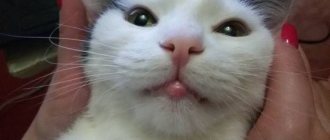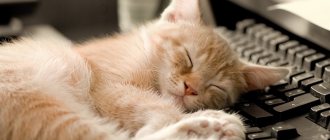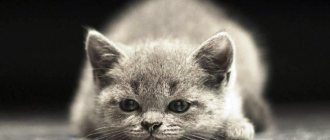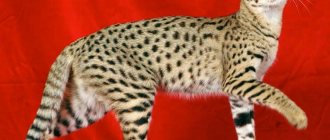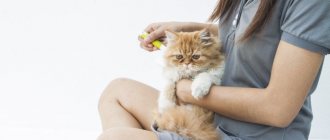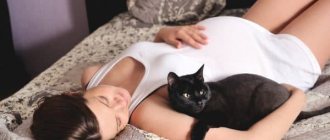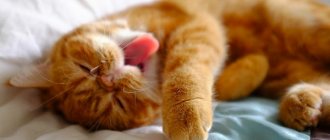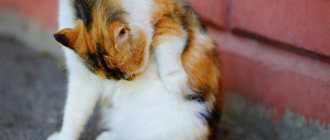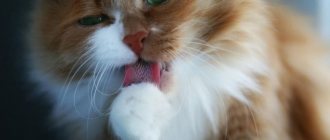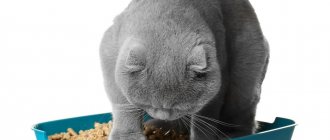Home » Useful Information
Increased salivation in cats can appear for completely harmless reasons, but in some cases the provocateur becomes a pathology that requires mandatory treatment. When such a clinical picture occurs, competent differential diagnosis is important, which will help to identify the disease in the pet at the initial stage.
- 2 Causes of hypersalivation
2.1 The main causes of hypersalivation in cats - video
- 4.1 Drugs that are used to eliminate the causes of hypersalivation - photo gallery
Saliva secretion norms
Saliva performs a number of important functions in the body. For example, it helps with the digestion of food, moisturizes it and helps with swallowing, due to its bactericidal properties it disinfects food, protects tooth enamel, as well as the cat’s tongue and gums from injury, etc. There are a number of situations when excessive salivation is normal and should not be scary hosts:
- when you see or smell food;
- before starting feeding;
- during chewing, especially dry food;
- under stress;
- after taking bitter or irritating medications, for example, anthelmintic drugs in tablets or suspensions.
Normally, you can detect the presence of saliva on your pet's fur and around its mouth. But if it begins to flow or a large amount is released and there is no tendency for it to decrease, you should consult a veterinarian.
The process of drooling or secretion of saliva is scientifically called salivation and is not a disease. If during examination the doctor speaks of hypersalivation (ptalism), you should not be afraid, this term means its excessive secretion.
Preventive measures
- Compliance with schedules of preventive vaccinations and antiparasitic treatments.
- Maintain hygiene: regular brushing of teeth, examination of the oral cavity.
- Keep household chemicals out of reach of the cat. When using acids, aerosols, varnishes and paints, isolate the animal from their effects.
- Protect your cat from stressful situations.
- Provide your pet with a balanced diet.
- Provide the animal with free access to clean and fresh water.
- Do not grow plants that are poisonous to cats in the house.
Signs of excessive drooling
In order to determine whether your pet has increased salivation, you need to pay attention to some factors in its behavior:
- the appearance of swallowing movements;
- the appearance of wet spots in the place where the cat sleeps, for example, on the bedspread;
- constant and repeated scratching of the muzzle on corners and protruding objects;
- the acquisition of an unkempt appearance of fur on the chest, neck and muzzle with sufficient care from the owners;
- lethargy of the tongue, falling out of the pet’s mouth;
- the formation of “icicles” on the cat’s fur coat.
Unusual symptoms
In addition to increased salivation, the cat also develops other symptoms:
- she cranes her neck;
- makes frequent swallowing movements;
- coughs;
- refuses to eat;
- behaves restlessly.
In such cases, it is necessary to urgently take the sick animal to a veterinary clinic to take an x-ray and quickly remove the foreign body. A special endoscope is used for this procedure. If you start helping the animal yourself and remove an object from the esophagus without special equipment, you can cause serious injury to the cat.
When the cat's tongue is on its side and drooling is very strong, then you also need to visit a doctor. This could be either ordinary food poisoning or an allergy to some product. Thus, qualified assistance will be required in any case. Contact our veterinary clinic as soon as possible if the question “why is the cat drooling” begins to torment you.
Types of hypersalivation
There are several types of it: banal and pathological, contagious and non-contagious. Moreover, some are not a sign of a serious pathology, while others, on the contrary, cause concern for the cat’s health.
Banal
There are a number of reasons for its development:
- The animal is overly affectionate and thus shows its love for its owners. When caressing or stroking a cat, when it begins to purr, saliva comes out of its mouth. Most often, a similar situation arises when keeping sphinxes and other breeds of animals with elongated muzzles. This condition can also develop during the period of sexual hunting. The only downside to this is drool on furniture and clothes.
- The presence of a foreign object in the oral cavity. In most cases, the cat chews the food thoroughly, but due to the special structure of the teeth (small distance between the alveolar processes and the lateral surface of the crown), food particles can get stuck there. The pet will try to pull out the foreign object, but he does not always succeed, which leads to excessive salivation. Therefore, before going to the veterinarian, it is worth examining the cat’s mouth yourself for the presence of food residues and removing them if found. If this fails, consult a veterinary clinic.
- Eating spiders and insects. Cats are extremely inquisitive by nature and will often eat a stray fly or moth. But many arthropods taste bitter, and some species of spiders contain toxic and bitter juices used to digest food. In this connection, irritation of the receptors in the pet’s mouth occurs, which is manifested by hypersalivation. If increased salivation does not go away on its own within 24 hours, or is accompanied by vomiting or diarrhea, you need the help of a specialist.
- Motion sickness. Many cats do not tolerate long trips well. If excessive salivation occurs in transport, this is a temporary process and will disappear on its own at the end of the trip. May be accompanied by vomiting and nausea.
- Licking antiparasitic drugs from fur. May cause poisoning resulting in increased salivation.
Pathological
This condition requires mandatory medical care for the animal and has a number of characteristic signs:
- increased salivation occurs at different times of the day, regardless of changes in the environment;
- the volume of saliva varies, and each time it becomes more and more;
- the attack lasts more than 2 hours;
- additional symptoms are present.
Main diseases and conditions causing pathological hypersalivation
Diseases that can cause hypersalivation.
Trichobezoar
This is a ball of ingested hair that forms in a pet's fat cat. There is thicker content and less active peristalsis. All cats swallow hairs when licking and most often they come out naturally, but sometimes such formations are formed from them. At the same time, in addition to increased salivation, other symptoms will be present: appetite decreases and water consumption increases, the pet’s stomach swells and when palpated, bloating in the large intestine is easily detected, long-term constipation occurs with a tendency to become chronic. A hairball can lead to complete blockage of the intestinal lumen, which in turn can cause low intestinal obstruction.
This condition requires urgent surgery. To identify a trichobezoar, research methods such as ultrasound and X-ray of the abdominal cavity are used.
Poisoning
This is a rare but possible condition in cats. The most common causes are: poisonous indoor plants, medications, mercury, household chemicals, expired food, rat bait, etc. When toxic substances enter the digestive tract, the body activates the elimination system, as it tries to get rid of toxins as quickly as possible. This is accompanied not only by increased salivation, but also by vomiting, nausea, and diarrhea. The pet refuses to eat, but at the same time begins to drink a lot, breathing becomes frequent and shallow. With a high concentration of poisons in the blood, general symptoms of intoxication develop, the functioning of the central nervous system, cardiovascular and respiratory systems is disrupted. This condition requires emergency veterinary care as it can be life-threatening.
Oral diseases
They can provoke increased salivation, among the most likely are:
- Mucoceles or cysts in the salivary glands. With this disease, the lumen of the salivary ducts is blocked, which leads to excessive accumulation of saliva in the organ and the formation of one or more cysts. An additional symptom is swelling and tenderness in the gland area.
- Gingivitis is an inflammatory disease of the gums. They become red, swollen and painful. In advanced stages, the cat may lose teeth.
- Abscess in the pulp of a tooth. This is a purulent process; it can be suspected not only by hypersalivation, but also by examining the mouth. Teeth have carious cavities, chips, cracks and other enamel damage.
Infectious diseases
Sometimes there are cases when drooling is caused by infectious diseases that are dangerous to the cat's health if left untreated. These include:
- Viral leukemia (feline leukemia). This disease develops as a result of a virus entering the body that affects white blood cells (leukocytes), which are responsible for immunity. Main symptoms: chronic stomatitis and gingivitis, leading to tooth loss. A cure for this virus has not yet been developed; only symptomatic therapy is carried out, aimed at maintaining the general well-being of the pet. The lifespan of a cat with leukemia is significantly reduced.
- Rabies is an extremely dangerous and contagious disease that affects not only animals, but also people. It is characterized by an increased flow of viscous saliva with copious amounts of foam from the mouth, fear of water and the sound of transfusions, excessive aggressiveness and inappropriate behavior, and convulsions are possible. The disease is incurable at the present time in the development of medicine. In this connection, the cat is euthanized and the corpse is burned. This is done to prevent infection of people and the spread of the disease.
Allergic reactions
Not only people, but also cats have allergies. It can be food, medicinal, etc. For example, with a sudden change from the usual food to another. If excessive drooling does not go away after 2-3 days, and is accompanied by vomiting, diarrhea or constipation, it is better to return to your previous diet.
Helminthiasis
The presence of worms in a pet's body can cause hypersalivation.
Diseases of the digestive tract and liver
In addition to increased salivation, such conditions and diseases are accompanied by an unpleasant, putrid odor from the cat’s mouth, and problems with bowel movements (diarrhea, constipation). With liver problems, both congenital and acquired, the process of neutralizing toxins entering the organ through the bloodstream is disrupted, which also provokes an increase in saliva volumes. At the same time, the pet’s nose becomes dry and warm, the tongue is coated with a thick brown coating. With congenital pathology, this condition develops in kittens in the first year of life, and with acquired pathology, this condition develops in adulthood.
Oncology
The development of tumors in the gastrointestinal tract can provoke increased salivation. This disease is difficult to diagnose due to the long absence of clear symptoms, and owners often turn to the veterinarian in advanced cases when the cat can no longer be helped. Old animals are most susceptible to this pathology, but it occurs at a young age.
Psychological reasons
There may be several of them:
- Excessive love for the owner. When stroking with pleasure, the cat may drool, which is not a sign of pathology.
- Stress. When moving, a large crowd of strangers in the apartment, the appearance of new pets, etc., the animal may feel emotional discomfort, which will manifest itself in the form of drooling.
Inflammation in the mouth
When hypersalivation occurs in cats, it is necessary to carefully examine the pet's mouth and gums. A fairly common cause of excessive salivation is inflammatory processes - stomatitis and gingivitis. With such pathologies, the oral mucosa appears reddened and a foul odor appears. Due to pain, the cat refuses to eat.
In case of inflammation, it is necessary to treat the oral mucosa with special gels with antibiotics and antiseptic solutions. During illness, the cat can only be given soft, ready-made pates. Gingivitis and stomatitis should not be neglected, as these pathologies can lead to loosening and loss of teeth.
Diagnostics
To find out the causes of this condition, the veterinarian will prescribe a number of manipulations:
- a complete examination of the pet and collection of anamnesis of the disease is carried out;
- a general and clinical stool blood test for helminthiasis is prescribed if helminthic infestation is suspected;
- the mouth is examined for the presence of foreign bodies;
- the condition of the teeth, the presence of chips, cracks, and carious cavities on them are studied;
- Ultrasound and radiography are performed to study the condition of the digestive tract and determine the presence or absence of foreign bodies and trichobezoars;
- A urine test is performed to identify concomitant pathologies and determine the general condition of the pet.
Other studies may be prescribed depending on the identified pathology.
Treatment
Tactics depend on the reasons that caused increased salivation. If it is an injury, ointments, drops and creams are prescribed. For psychological problems - sedatives. For diseases of internal organs - complex therapy taking into account the identified pathology. In each case, a scheme suitable for a particular cat is selected.
Self-medication and giving medications is not safe for the health and life of the pet and its owners, since only a specialist can distinguish a contagious from a non-contagious disease.
Mr. Cat recommends: preventing clear drooling
By following simple rules, you can avoid excessive drooling in your pet. Among the main ones are:
- keep all medications, toxic substances and household chemicals out of reach to prevent your pet from eating them;
- stop growing poisonous indoor flowers or put them in another room where the animal has no access;
- regularly independently examine the cat’s mouth so as not to miss the onset of the infectious process;
- Constantly monitor the animal’s diet, exclude sharp bones and excessively hard particles from it;
- flea medications should be dripped onto the fur in a place where the cat cannot lick it (for example, on the withers);
- timely vaccination against infectious diseases;
- Take your pet to the veterinarian at least once a year for a preventive examination.
It is important to remember that with any changes in the animal’s condition, it is better to consult a specialist rather than hope that it will go away on its own.
Milk teeth and their replacement
Kittens are born toothless. In the second week of life, their baby teeth should grow in. The process is completed by 3-4 months. The normal physiological process of replacing baby teeth with permanent teeth begins immediately. By the age of seven months, this process is completed.
Sick cat
During this period, the pet’s oral cavity and gum condition are monitored. An animal is considered adult when it has 30 teeth:
- incisors - fix prey, 12 pieces (equally on the upper and lower jaws);
- fangs - animals use them to kill prey, 4 pieces (one each to the left and right of the incisors on both jaws);
- premolars - small molars, 10 pieces (4 at the top, 6 at the bottom);
- molars - grind food, 4 pieces (equally on each jaw).
